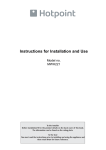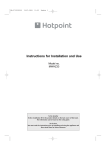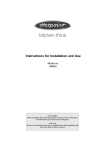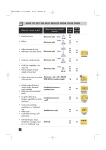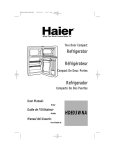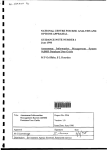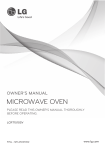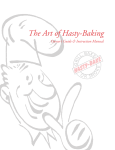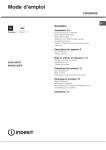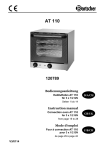Download Hotpoint MWH211 User's Manual
Transcript
Instructions for Installation and Use Model no. MWH211 ELECTRICAL CONNECTION A) If your appliance comes fitted with a plug, it will incorporate a 13 Amp fuse. If it does not fit your socket, the plug should be cut off from the mains lead, and an appropriate plug fitted, as below. WARNING: Very carefully dispose of the cut off plug after removing the fuse: do not insert in a 13 Amp socket elsewhere in the house as this could cause a shock hazard. With alternative plugs not incorporating a fuse, the circuit must be protected by a 15 Amp fuse. If the plug is a moulded-on type, the fuse cover must be re-fitted when changing the fuse using a 13 Amp Asta approved fuse to BS 1362. In the event of losing the fuse cover, the plug must NOT be used until a replacement fuse cover can be obtained from your nearest electrical dealer. The colour of the correct replacement fuse cover is that as marked on the base of the plug. B) If your appliance is not fitted with a plug, please follow the instructions provided below: WARNING - THIS APPLIANCE MUST BE EARTHED IMPORTANT The wires in the mains lead are coloured in accordance with the following code: E Green and yellow: Earth L Blue: Neutral N Brown: Live As the colours of the wires in the mains lead may not correspond with the coloured markings identifying the terminals in your plug, proceed as follows: The green and yellow wire must be connected to the terminal in the plug marked with the letter E or the earth symbol or coloured green or green and yellow. The blue wire must be connected to the terminal marked with the letter N or coloured black. The brown wire must be connected to the terminal marked with the letter L or coloured red. Data and instruction for Performance Tests according to IEC 60705 and EN 60705 (19999-04) The International Electrotechnical Commission SC 59H, has developed a Standard for comparative testing of heating performances of microwave ovens. We recommend the following for this oven: Test Nr. on standard Item 12.3.1 900w 700w output power output power Function Power Weight Standing level time Note Duration Duration Egg custard 14’ - 16’ 18’ - 20’ only MW 750 gr 5 min. The upper surface shall be evaluated after the standing time. The inner custard evaluation shall be conducted after two hours. 12.3.2 Sponge cake 6’ - 7’ 8’ - 9’ only MW 475 gr 5 min. Use the borosilicate glass container stated in the Standard (max dia. 210 mm) or a Pyrex® glass container dia. 210 mm, height 50 mm and wall thick. 6mm. 12.3.3 Meat loaf 18’ - 20’ 22’ - 24’ only MW 900 gr 5 min. Cover the container with cling film and pierce the film. Use the rectangular borosilicate glass container stated in the Standard or the Arcopal® Cat. nr Z1/B8 (01)10460-1 13.3 Defrosting minced meat 6’ - 8’ 9’ - 11’ only MW 500 gr 15 min. 2 Place the frozen load directly on the turnable (D). Turn upsidedown the load after half of the defrosting time. CONTENTS DESCRIPTION . . . . . . . . . . . . . . . . . . . . . . . . . . . . . . . . . . . . . . . . . . . . . . . . . . . . . . . . . . .3 HOW TO GET THE BEST RESULTS FROM YOUR OVEN . . . . . . . . . . . . . . . . . . . . . . . . . . . . . . . . . . . .4 IMPORTANT SAFEGUARDS . . . . . . . . . . . . . . . . . . . . . . . . . . . . . . . . . . . . . . . . . . . . . . . . . . . .5 INSTALLATION . . . . . . . . . . . . . . . . . . . . . . . . . . . . . . . . . . . . . . . . . . . . . . . . . . . . . . . . . . .6 OUTPUT POWER . . . . . . . . . . . . . . . . . . . . . . . . . . . . . . . . . . . . . . . . . . . . . . . . . . . . . . . . .6 TECHNICAL DATA . . . . . . . . . . . . . . . . . . . . . . . . . . . . . . . . . . . . . . . . . . . . . . . . . . . . . . . . .7 ELECTRICAL CONNECTIONS . . . . . . . . . . . . . . . . . . . . . . . . . . . . . . . . . . . . . . . . . . . . . . . . . . .7 GLASSWARE AND SIMILAR ITEMS . . . . . . . . . . . . . . . . . . . . . . . . . . . . . . . . . . . . . . . . . . . . . . . .7 DESCRIPTION AND USE OF THE CONTROLS . . . . . . . . . . . . . . . . . . . . . . . . . . . . . . . . . . . . . . . . . .8 ADVICE ON USING YOUR OVEN CORRECTLY . . . . . . . . . . . . . . . . . . . . . . . . . . . . . . . . . . . . . . . .10 SIMULTANEOUS COOKING ON 2 LEVELS . . . . . . . . . . . . . . . . . . . . . . . . . . . . . . . . . . . . . . . . . .11 HOW TO PROGRAMME AUTOMATIC DEFROSTING . . . . . . . . . . . . . . . . . . . . . . . . . . . . . . . . . . . . .13 HOW TO PROGRAMME THE OVEN SO AS TO KEEP FOOD HOT, TO REHEAT AND TO COOK . . . . . . . . . . . .15 CLEANING AND MAINTENANCE . . . . . . . . . . . . . . . . . . . . . . . . . . . . . . . . . . . . . . . . . . . . . . .20 DESCRIPTION A B C D E F Control panel Turntable spindle Interior, door side Turntable Turntable support Microwave outlet cover A F B D C E Some models have a seperator or spacer wire rack that makes it possible to cook two food dishes at the same time (simultaneous insertion of two plates or pans). Consult the instructions given on page 11 3 HOW TO GET THE BEST RESULTS FROM YOUR OVEN What do I want to do? What power should I choose? • Keep food warm Power level 1 • Defrost Power level 1 • Melt butter and soften cheese • Cook meat • Heat pastry goods • Cook fish • Cook vegetables • Cook rice, pasta • Heat up all types of ready cooked or frozen food • Cook fruit • Defrost, reheat, cook on two levels at the same time 23 lt 17 lt 300w 235w Use Instr. page 15 15 13 14 15 15 16 17 19 17 19 610w 15 17 17 700w 15 18 19 15 18 19 16 19 19 11 12 2 480w 375w 3 600w 470w Power level 4 780w Power level Power level 5 900w Microwave only with (SPACER LEVEL) (Not with all models) Disposal of old electrical appliances The European Directive 2002/96/EC on Waste Electrical and Electronic Equipment (WEEE), requires that old household electrical appliances must not be disposed of in the normal unsorted municipal waste stream. Old appliances must be collected separately in order to optimise the recovery and recycling of the materials they contain and reduce the impact on human health and the environment. The crossed out “wheeled bin” symbol on the product reminds you of your obligation, that when you dispose of the appliance it must be separately collected. Consumers should contact their local authority or retailer for information concerning the correct disposal of their old appliance. 4 Amt. & time chart page IMPORTANT SAFEGUARDS Read carefully these instructions and keep for future reference. N.B. This oven has been designed to defrost, heat and cook food in the home. It must never be used for other purposes, modified or tampered with in any way. 1) WARNING: If the door or door seals are damaged, the oven must not be operated until it has been repaired by a competent person (trained by the manufacturer or by its Customer Service). 2) WARNING: It is hazardous for anyone other than a competent person to carry out any service or repair operation which involves the removal of a cover which gives protection against exposure to microwave energy. 3) WARNING: Liquids and other foods must not be heated in sealed containers since they are liable to explode. Eggs in their shell and whole hard-boiled eggs should not be heated in microwave ovens since they may explode even after microwave heating has ended. 4) WARNING: Accessible parts may become hot during use. Young children should be kept away. The appliance is not intended for use by young children or infirm persons. Young children should be supervised to ensure that they do not play with the appliance. Only allow children to use the oven without supervision when adequate instructions have been given so that the child is able to use the oven in a safe way and understands the hazards of improper use. 5) Do not attempt to operate the oven with the door open by tampering with the safety devices. 6) Do not operate the oven if objects for any kind get stuck between the front panel of the oven and the door. Always keep the inside of the door (C) clean, using a damp cloth and non-abrasive detergents. Do not allow dirt or remains of food to accumulate between the front panel of the oven on the door. 7) Do not operate the oven if the supply cable or the plug is damaged, as this may result in electric shocks. If the supply cable has been damaged, it must be replaced by the manufacturer or the technical service centre or by a qualified person so as to avoid all risks. 8) If smoke is observed, switch off or unplug the appliance and KEEP THE DOOR CLOSED in order to stifle any flames. 9) Only use utensils that are suitable for use in microwave ovens. In order to avoid overheating and the consequent risk of fire, it is advisable to supervise the oven when cooking food in disposable containers made of plastic, cardboard or other inflammable materials, and when heating small quantities of food. 10) Never place the turntable in water after it has ben heated for a long time. The high thermal shock resulting would break the turntable. 11) When cooking "Only MICROWAVE", you absolutely must not pre-heat the oven (without foodstuffs in it) and you must not operate it when it is empty, because you might cause sparking. 12) Before using this oven, check to be certain that the utensil and containers chosen are suitable for microwave oven use (see the section on "Glassware and Similar Items"). 13) During the use the appliance becomes hot. Do not touch the heating elements inside the oven. 14) When heating liquids (water, coffee, milk, etc.) it is possible that the contents may suddenly start to boil and spill violently as a result of delayed boiling, causing scalding. To avoid this happening, you should place a heat-resistant plastic spoon or a glass rod in the container before starting to heat liquids. Anyway, care shall be taken when handling the container. 15) Do not heat spirit with a high alcohol content, nor large quantities of oil, as these could catch fire! 16) The contents of feeding bottles and baby food jars shall be stirred or shaken and the temperature shall be checked before consumption in order to avoid burns. It is also advisable to stir or shake 5 the food in order to ensure that it has an even temperature. 17) Failure to maintain the oven in a clean condition could lead to deterioration of the surface that could adversely affect the life of the appliance and possibly result in a hazardous situation. 18) Do not use harsh abrasive cleaners or sharp metal scrapers to clean the oven door glass since they can scratch the surface, which may result in shattering of the glass. 19) All microwaves are tested and approved in accordance with current electromagnetic safety and compatibility regulations and standards. As a precautionary measure, pacemaker manufacturers recommend wearers to keep a minimum distance of 20-30 cm between an operating microwave oven and the pacemaker in order to avoid possible interference with the pacemaker. If you suspect that such an interference is occurring, turn the oven off immediately and contact the pacemaker manufacturer. 20) The door or the outer surface may get hot when the appliance is operating. When using commercially available bottle sterilisers, before turning the oven on, ALWAYS make sure the container is filled with the quantity of water indicated by the manufacturer. INSTALLATION 1) After having removed the oven from its box, check to make certain that the turntable spindle (B) is correctly fitted into its housing. Place the turntable support (E) in the middle of the cooking chamber and set the turntable (D) on top of it. The spindle (B) must be inserted in the related turntable housing. 2) Check to make certain that this equipment has not been damaged in transport and check especially to see if the door opens and closes correctly. 3) Place this oven on a surface so that there remains a space of about 5 cm. between the oven’s surface portions and the walls to the side and the back, and a free space of at least 20 cm. above the oven. 4) Never block up or otherwise obstruct the air outlet holes. In particular, never place anything on the oven and check to be certain that the air and steam outlet slots (located atop the oven) are ALWAYS FREE. 5) DO NOT remove the transparent film on the inner surface of the door. 6) The majority of modern electronic appliances (TV, radio, stereo systems etc) are shielded from radio frequency (RF) signals. Certain electronic appliances may not, however, be shielded from radio frequency signals deriving from a microwave oven. You should therefore keep a distance of at least 1 - 2 metres between these appliances and the operating oven. OUTPUT POWER The microwave output power is written on the rating plate placed on the rear side of the appliance (see “MICRO OUTPUT”). When you consult the tables, always look up your oven’s output power. It will be useful also when you are consulting cookbooks intended for use with microwave ovens. ONLY FOR SOME MODELS: The microwave output power is also indicated inside this simbol, placed on the oven door. (ONLY FOR U.K.) The letter indicates the heating category to which your oven belongs: some pre-cooked food packages (frozen or chilled) give heating instructions corresponding to the various categories. Follow those instructions related to the category indicated for your oven. The levels of intermediate power available are shown on page 4. This information will be useful for you to consult the prescription pads for microwaves currently on sale. 6 TECHNICAL DATA M O D E L W I T H A 2 3 - L I T R E C AV I T Y Outer measurements (LxDxH) 508x305x414 Inner measurements (LxDxH) 350x215x330 Approximate weight 16 kg. Turntable diameter 31,4 cm Oven light 20 W M O D E L W I T H A 1 7 - L I T R E C AV I T Y Outer measurements (LxDxH) 458x295x380 Inner measurements (LxDxH) 300x206x284 Approximate weight 14 kg. Turntable diameter 24,5 cm Oven light 20 W B O T H M O D E L S For additional data, consult the serial plate glued to the back of the equipment. This appliance conforms to EC directive 2004/108/EC on Electromagnetic Compatibility and EC regulation no. 1935/2004 of 27/10/2004 on materials intended for contact with food. The product is classified as Group 2, Class B ISM equipment in conformity to standard EN 55011, paragraph 4. ELECTRICAL CONNECTIONS Connect this equipment only to electrical outlets having a capacity of at least 10A. Before using this oven, check to make certain that the electrical network is the same as that indicated on the equipment’s data plate and that the electrical outlet is connected to an efficient grounding (earth) terminal. The manufacturer shall not be responsible in any manner whatsoever for harm or damage caused by failure to observe this norm. • Electrical Connection for UK only . . . . .see page 2 GLASSWARE AND SIMILAR ITEMS You can make use of all types of containers made of glass (preferably Pyrex), ceramics, porcelain and glazed pottery as long as they do not have decorations or metal parts (gilded borders, handles, feet). Heat resistant plastic containers can also be used, but only for “Microwave Only” cooking. If you are still doubtful about using a particular container, you can perform a simple test. Place the empty container in the oven for 30 seconds at maximum power (“Microwave Only” function). If the container is still cold or only slightly warm, it is suitable for microwave cooking. If it is very hot or gives out sparks, it is not suitable. For short heating periods, you may use paper napkins, cardboard trays and plastic “throwaway” plates as a base. As far as shape and size are concerned, it is absolutely essential that containers be such as to allow the turntable to rotate. In order to use large-size rectangular containers (which may not be able to rotate inside the cooking cavity), you can remove the spindle (B) from its housing to prevent the turntable (D) moving. Bear in mind that to be assured of good results when carrying this out you must stir the food and turn the container around several times during the cooking process. Containers made of metal, wood, recycled kitchen paper, cane and plate glass are not suitable for use in microwave ovens. The metal rack supplied with your microwave have been fully tested for safe use. You should remember, too, that since microwaves heat the food and not the glassware, earthenware or similar containers for that food, it is possible to cook such foods in the serving dish and thereby avoid the problem of having to clean pans later. However, remember that heat may be transferred from the food itself to the plate, making it necessary to use an oven glove. In any case, observe the guidelines shown in the following table: Glass Ceramics Porcelain Clay plates Plastic for microwaves Paper cups* Paper plates* Parchment paper* Cardboard Metal Glasswith contain- ware metal parts ers Defrosting YES YES YES YES YES YES YES YES YES NO NO YES Heating YES YES YES YES YES YES YES YES YES NO NO YES Cooking YES YES YES YES YES NO NO NO NO NO NO YES Special roasting paper * If the cooking time required is too long, there is a possibility of fire. 7 DESCRIPTION OF CONTROLS Display Display cooking time and power level “Power Level” button • Select power level • 5 power level “Stop/Start” button Start or stop cooking “Clock/Reset” button • Set the clock • Stop cooking and reset the oven “- Time +” knob • Select cooking time • change power level or time during cooking HOW TO USE CONTROL PANEL Plug the AC cord of the oven on a wall socket of 230V~50HZ 10/16A. CLOCK: Before the first use and after disconnection power, it is better to update the clock • Push on the button “Clock/Reset” for more than 3 seconds, the clock is on “00:00” e emits a long sound signal. • The 2 dots of the display flick, which indicates that you are on the clock. • Turn the “- Time +” knob to update minutes. • Push again the “Clock/Reset” button to confirm. Flickering of the 2 dots indicates that you are on a clock operation mode and not on cooking mode. 10 seconds after the end of cooking time, the display automatically back to clock mode. 8 SELECTION OF COOKING TIME: Use “- Time +” knob to select the cooking time. A rotation from right to left increase selected tim and the opposite reduces it. From “00:00” to “05:00” minutes, the increment is 10 seconds. After “05:00”, is the increment is 1 minute. Timer is up to 30 minutes. SELECTION OF POWER: The standard power level is the maximum level. For a fast operation it is better to select only time with the “- Time +” knob and launch cooking with the “Stop/Start ” button. You can also adjust the power level by pushing the “Power Level” button. Each push reduces cooking power level, until the lowest level (indicated by the left icon on the display). If you continue to push, you progressively go back to the highest levels. At the end of cooking, the oven automatically resets the highest levels. At the end of cooking, the oven automatically resets the highest power level. START: Push the “Stop/Start” button to launch cooking. The internal lamp lights on, the glass plate starts to turn and cooking starts. At the same time, the display starts to count down until the end of operating or the user stops the unit. SUSPEND: You can open the door during cooking. This suspend the cooking process and count down. It is not necessary to push the “Stop/Start” button or to reprogram time. If food is cooked enough or if you want to take it out from the oven, you should push the “Stop/Start” button or the reset key marked “00:00” before closing the door, because the oven should not be used without anything inside. STOP COOKING: By pushing the “Stop/Start” button, you can stop cooking. Timer is stopped but time is still on display. If you push again on “Stop/Start” button, cooking restart for the remaining time indicated on the display. RESET: 5 minutes after pushing the “Stop/Start” button, if your oven is not used, power level is automatically reset to maximum and time is reset to zero. You can push the “Clock/Reset” button to definitively stop cooking and reset the oven. CHANGE POWER LEVEL OR TIME DURING COOKING: To change the cooking time during cooking, turn the “- Time +” knob from right to left to increase cooking time and in the opposite direction to decrease. By bringing the timer to “00:00” you stop cooking. To change the cooking power level, push on “Power Level” button. The display indicates the new power level but the last program will first finish before changing power level. 10 seconds after the end of cooking or after stopping the unit, the display returns to the Clock mode as indicated by the 2 points flicking. 9 ADVICE ON USING YOUR OVEN CORRECTLY Microwaves consist of electromagnetic radiation found in nature under the form of light waves (e.g., sunlight). Inside the oven, these waves penetrate food from all directions and heat up the water, fatty and sugar molecules. Heat is produced very quickly only in the food itself, whereas the container being used warms up indirectly by means of heat given off by the heated food. This prevents food from sticking to its container, so you can use very little fatty sub- stance or, in some cases, no fat at all during the cooking process. Therefore cooking in a microwave oven is considered to be healthy and good for one’s diet. And in contrast to traditional methods, cooking in a microwave foodstuffs are less dehydrated, lose less of their nutritional value, and retain more of their original flavour. Basic rules for correct cooking with a microwave oven 1) In order to set cooking times correctly, remember (in referring to the charts on the following pages) that when you increase the amount of foodstuffs the cooking time must likewise be proportionately increased and vice-versa. It is important to respect the “standing” times: standing time means that period during which the food must be left to “rest” after being cooked so as to allow an even greater spreading of the temperature within. The temperature of meat, for example, will rise about 5°-8° C. (approx. 9°-15° F.) during the standing time. Standing times may be observed either inside or outside the oven. 2) One of the main things you must do is stir the food where appropriate several times while it is being cooked. This helps distribute the heat more uniformly and thus shortens the cooking time. 3) It is also advisable to turn the foodstuff over where appropriate during its cooking process: this applies especially for meat, whether it is in large pieces (roasts, whole chickens, etc.) or small (chicken breasts, etc.). 4) Foods with a skin, shell or peel (e.g., apples, potatoes, tomatoes, frankfurters, fish) must be pierced with a fork or sharp knife in several points so as to allow steam to escape and prevent exploding. 5) If you are preparing a large number of portions of the same food item (e.g., boiled potatoes), place them in a large dish to allow uniform cooking. 6) The lower the temperature at which a foodstuff is placed in a microwave oven, the longer the cooking time required. Food having a room temperature will cook more quickly than food having a refrigerator temperature. 7) Always cook by placing the food container in the centre of the turntable. 8) It is perfectly normal for condensation to form inside the oven and near the air outlet. To reduce such condensation, cover the foodstuffs with clear-film, wax paper, a glass lid or simply an overturned plate. Foods having a water content (e.g., greens and vegetables) cook better when covered. The covering of food also helps keep the oven clean on the inside. Make sure when using clear films that they are suitable for microwave use. 10 USE THE MICROWAVE-ONLY FUNCTION WHEN COOKING ON TWO LEVELS AT THE SAME TIME Only for models provided with a spacer wire rack By using the spacer grill with the microwave-only function, you can defrost, reheat and cook foods at the same time, even different dishes on two levels. The special double-microwave-emission system makes possible, in fact, a perfect distribution of energy. When you wish to cook two food dishes at the same time, all you have to do is keep these basic rules in mind: 1) The cooking times for food dishes cooked at the same time are different from those for the cooking of single dishes. So always consult the reference table on page 12. Times for simultaneous cooking Potatoes 24 min (above) Goulash 48 min (below) Cooking times for single dishes Potatoes Goulash 10 - 14 min 35 - 40 min 2) Be careful to ALWAYS place on the SPACER WIRE RACK that food which requires less cookig time: it will thus be easier to remove the upper pan. Take the wire rack out and finish cooking the food underneath. Upper food dish (less time) Lower food dish (more time) Spacer wire rack Turntable 3) Pay strict attention to the indications and recommendations in the tables. In particular, always check to be sure that the food being reheated is very hot before removing it from the oven. 11 REFERENCE TABLES FOR COOKING ON TWO LEVELS Defrosting times • • • • • • Type Pan position Quantity (grams) Ground meat Ground meat Chicken in pieces Stew Cauliflower Whole fish above below above below above below 500 500 500 500 450 500 Pan position Quantity (grams) above below above below above below 150 250 500 500 150 500 Pan position above below above below above below above below above below above below above below above below above below above below above below Quantity (grams) Power level Minutes 20 20 24 24 22 22 Notes Turn the meat over after 8 min. When the cooking is finished, let the meat sit for 15 min. During the defrosting, pull the pieces apart. When the cooking is finished, let the meat sit for 15 min. At the end, let sit for 5 to 10 min. At the end, let sit for 5 to 10 min. Reheating times Type • • • • • • Meat, single serving Vegetables, single serving Plate of lasagne Plate of lasagne Meat, single serving Plate of lasagne Power level Minutes 6 6 9 9 6 8 Notes Cover Cover Cover Cover Cover Cover the the the the the the food food food food food food with with with with with with plastic plastic plastic plastic plastic plastic wrap wrap wrap wrap wrap wrap Cooking times Type • • • • • • • • • • • • • • • • • • • • • • 12 Potatoes Potatoes Carrots Carrots Sliced fish Zucchini Whole fish Zucchini Whole fish Whole fish Potatoes Goulash Rice Cabbage Peas Brussels sprouts Meat loaf Potatoes Sausages Sausages Stew Pork roast 500 500 500 500 400 475 200 475 200 200 500 1500 300 500 500 500 500 500 300 300 700 700 Power level Minutes Notes 20 20 16 16 13 15 11 14 11 11 20 40 22 22 20 20 30 30 22 22 36 36 Cut in equal-size pieces and cover with plastic wrap. Cut in equal-size pieces and cover with plastic wrap. Cut in equal-size pieces and cover with plastic wrap. Cut in equal-size pieces and cover with plastic wrap. Cover with plastic wrap. After 13 min., take out the grill. Leave whole and cover with plastic wrap. Cover with plastic wrap. After 11 min., take out the grill. Leave whole and cover with plastic wrap Cover with plastic wrap. Cover with plastic wrap. Cut in equal-size pieces and cover with plastic wrap. After 24 min., take out the grill. Stir 2 or 3 times. Cover with plastic wrap and stir 2 times Leave whole and cover with plastic wrap Cover with plastic wrap. Cover with plastic wrap. If needed, turn over at the halfway point Cover with plastic wrap. Stir 1 or 2 times Stir 1 or 2 times Stir 1 or 2 times Turn over at the halfway point HOW TO PROGRAMME THYE DEFROST FUNCTION To correctly use this function, both the microwave power level and the defrost time must be set. 1. Press the “Power Level” button until the ” ” symbol appears. 2. Set the required time by turning the “- Time +” knob. 3. Press the “Stop/Start” button to start defrosting. 4. At the end of the set time a single “beep” will be emitted and the display will show “00:00”. • If the door is opened to check the progress of the defrost, the microwave will stop and the display will show the remaining time. Close the door to continue defrosting. The oven will start counting the time from it was stopped at. Pressing the “Stop/Start” button before opening the door stops the count and switches off the oven; open the door to check the progress of the defrost. Close the door and press the “Stop/Start” button to restart the defrost cycle. • To reset the timer, proceed as follows: - with the oven door open: press the “Clock/Reset” button once - with the oven in operation: press the “Clock/Reset” button once - with the oven off and the door closed: press the “Clock/Reset” button once Using the microwave-only function for defrosting • Foods frozen in bags or plastic sheeting or in their packaging may be placed directly in the oven, as long as they have no metal parts (e.g., bands or closure rivets). • Certain foods, such as greens, vegetables and fish, do not have to be completely defrosted before you begin cooking them. • Stewed foods and meats as well as meat sauces defrost better and quicker if they are stirred from time to time, turned over or separated. • While defrosting, meat and fish lose their liquid content. It is recommended, therefore, that you defrost such items in a tray or basin. • It is advisable to separate each individual piece of meat from its bag before putting it in the freezer. This will help you save valuable time will preparing foods. • Be careful about following the cooking times printed on frozen products, because those times are not always correct. It is best to use defrosting times slightly less than those indicated. The time needed for defrosting will vary in terms of the degree to which the food has been frozen. 13 Defrosting times The times indicated on the chart (timer knob) vary in relation to your oven’s output power. The output power figure is printed on the oven door, inside the symbol (see page 6). Type MEAT • Roasts (pork, beef, veal, etc.) • Steaks, cutlets, meat slices • Stew, goulash • Ground meat “ • Hamburger • Sausages POULTRY • Duck, turkey • Whole chickens • Cut-up chicken • Chicken breasts VEGETABLES • Cubed eggplant • Cut-up peppers • Shelled peas • Artichoke hearts • Pieces of asparagus • Cut-up green beans • Whole broccoli • Brussels sprouts • Cut-up carrots • Cauliflower tops • Mixed vegetables • Cut-up spinach FISH • Filleted fish • Cut-up fish • Whole fish • Prawn, shrimps DAIRY PRODUCTSI • Butter Quantity 1 kg 200 500 500 250 200 300 900W output power 700W output power Time to be set (minutes) Time to be set (minutes) 15 - 17 18 - 20 20 5 10 15 10 10 10 gr gr gr gr gr gr 2 6 6 3 3 5 - 4 8 8 5 5 7 5-7 9 - 11 9 - 11 6-8 6-8 8 - 10 1,5 kg 1,5 kg 500 gr 300 gr 25 25 6 6 - 28 28 8 8 29 - 33 29 - 33 9 - 11 9 - 11 500 500 500 300 500 500 500 500 500 450 300 300 gr gr gr gr gr gr gr gr gr gr gr gr 9 - 11 8 - 10 7-9 5-7 6-8 8 - 10 7-9 7-9 6-8 7-9 4-6 5-7 12 - 14 11 - 13 10 - 12 8 - 10 9 - 11 11 - 13 10 - 12 10 - 12 9 - 11 10 - 12 7-9 8 - 10 300 400 500 400 gr gr gr gr 5 6 6 6 8 9 9 9 - 7 8 8 8 - 10 11 11 11 250 gr 2-4 5-7 • Cheese 250 gr 3-5 6-8 • Cream 200 ml 5-7 8 - 10 150 300 250 250 1 2 2 2 3 4 4 4 BREAD PRODUCTS • 2 average-size rolls • 4 average-size rolls • Sliced home-style bread • Whole-wheat bread FRUIT • Strawberries, prunes, cherries, currants, apricots • Raspberries • Blackberries gr gr gr gr - 2 3 3 3 - 5 6 6 6 Notes (*) At the end of the rest period, wash under hot water to remove possible ice To make defrosting easier, stir the vegetables from time to time Fish is better cook from frozen if it does not require further preparation. Standing time (minutes) 20 20 10 10 5 5 5 5 5 5 5 5 5 5 5 5 7 7 7 7 Remove the aluminium paper and metal pieces. Partially defrosted. Needs the standing time. Cream is to be removed from its container and put on a plate. 10 Put the bread directly on the turntable 3 3 3 3 15 5 500 gr 6-8 9 - 10 Mix 2 or 3 times 10 300 gr 250 gr 4-6 2-4 7-9 5-7 Mix 2 or 3 times Mix 2 or 3 times 10 6 (*) These indications are suitable for performing the minced meat defrosting test according to Regulation 60705, Par. 13.3 (see page 2). Turn over halfway through the set time. Place directly on the turntable. Further information, including on other performance tests according to Regulation 60705, is given in the table on page 2. 14 HOW TO PROGRAMME THE OVEN SO AS TO KEEP FOOD HOT, TO REHEAT AND TO COOK 1. Press the “Power Level” button until the required power is selected ( = maximum; = minimum). If the “Power Level” button is not pressed, the oven will operate at maximum power . The indication at the bottom of the display shows the power level selected. 2. Set the required time by turning the “- Time +” knob. 3. Press the “Stop/Start” button to start the function. The display shows the set time and the power level. 4. At the end of the set time a single “beep” will be emitted and the display will show “00:00”. • You can check on the progress whenever you please by opening the oven door and taking a close look at the foodstuff. By doing so, you interrupt the microwaves, but their emission will resume when you close the door again. • If for any reason whatsoever it becomes necessary to interrupt the cooking without opening the door, simply push the “Stop/Start“ button. • To stop the cooking, do as follows: - if the oven door is open, push the “Clock/Reset” button once; - if the oven is operating, push the “Clock/Reset” button once; - if the oven is turned off and its door closed, push the “Clock/Reset” button once. • The cooking time and the microwave power may be changed even after you have pushed the “Stop/Start“ button. KEEPING FOOD WARM • This function enables you to keep food hot, whether that food be just cooked or re-heated, without having it get dry or stick to its container. • Selecting the power level “ “ and covering the food with a plate or plastic film, you will find that foods will remain warm up to serving time • You can leave foods in their cooking container if they are covered. HEATING Heating food in a microwave oven is much quicker and energy efficient than traditional methods. • We recommend that you heat foodstuffs (especially if they are frozen) to a temperature of at least 70° C. (it must be piping hot!). Leave to stand for a few minutes as you will not be able to eat that food immediately because it will be too hot. • This will ensure that any possible bacteria present in food will have been killed. • To heat pre-cooked or frozen foods, follow these rules: - remove the food from its metal containers; - cover it with plastic wrap (the clear-film type suitable for microwave ovens) or wax paper; in this way, all the food’s natural flavour will be preserved and the oven will stay cleaner; you may also cover the food with an upside-down plate; - if possible, stir or turn the food over frequently so as to speed up the heating process and keep the heat uniform at the same time; - follow the cooking times listed with great caution; remember that under certain conditions the timings given must be lengthened • Frozen foods must be defrosted before the heating process begins. The lower the food’s initial temperature, the longer the time needed for heating. • Foodstuffs and drinks may be heated briefly in paper or plastic containers. In any event, however, such containers may become misshapen if the heating time is too long. 15 Heating times The times indicated on the chart (timer knob) vary in relation to your oven’s output power. The output power figure is printed on the oven door, inside the symbol (see page 6). Type SOFTENING FOOD • Chocolate/icing • Butter Quantity power level 100 gr 50 -70 gr 700W 900W output power output power time (min.) time (min.) 4-5 5-6 Notes Put on a plate. Mix the icing once. 0’.5”-0’.10” 0’.7”-0’.12” CHILLED FOOD (INITIAL TEMP. 5/8°C) UP TO 20/30°C 125 gr 0’.10”-0’.15” 0’.12”-0’.17” Remove metal foil • Yoghurt “ 240 gr 0’.25”-0’.30” 0’.35”-0’.40” Heat the baby’s bottle without the teat • Baby’s bottle “ and mix it immediately after heating to make the temperature uniform. Check the temperature of the contents before use. With milk at room temperature the heating time is lower. To avoid risk of fire when using dried milk please stir evenly. Please use already sterilized milk. CHILLED PRECOOKED FOOD (INITIAL TEMP. 5/8°C) UP TO APPROX. 70°C • Packet of lasagne or of 400 gr 4-6 6-8 “ pasta with filling • Packet of meat with and/or 400 gr 4-6 6-8 “ vegetables 3-5 5-7 • Packet of fish and/or 300 gr “ vegetables 7-9 • Plate of meat and/or 5-7 400 gr “ vegetables • Plate of pasta, cannelloni or 400 gr 7-9 5-7 “ lasagne 6-8 300 gr • Plate of fish and/or rice 4-6 “ Packets of any kind of commercially available pre-cooked food, to be heated to a temp. of 70° C. Remove the food from any rice metal packets and put it directly onto the plate from which it is to be eaten. For best results, always cover the food. Portions of any kind of already cooked food, to heat to a temp. of 70°C. The food is placed directly onto the plate from which it is to be eaten and is always covered either with a transparent film or with an upturned plate. FROZEN FOOD TO REHEAT/COOK (INITIAL TEMP. -18°/-20°C) UP TO APPROX. 70°C • Packet of lasagne or of pasta with filling • Packet of meat with rice and/or vegetables • Packet of fish and/or precooked vegetables • Packet of fish and/or raw vegetables • Portion of meat and/or vegetables • Portion of pasta, cannelloni or lasagne • Portion of fish and/or rice 400 gr “ 6-8 8 - 10 400 gr “ 5-7 7-9 300 gr “ 3-5 5-7 300 gr “ 8 - 10 10 - 12 Remove the raw food from the packets and place it in a container suitable for microwaves and cover. 400 gr “ 6-8 8 - 10 400 gr “ 7-9 9 - 11 300 gr “ 4-6 6-8 Portions of any kind of already cooked frozen food, to be heated to a temperature of 70°C. Place the frozen food in the plate from which it is to be eaten and cover it with another upturned plate or pyrex dish. Check that it is hot in the centre; where possible, mix the food. Packets of any kind of commercially available pre-cooked frozen food, to be heated to a temp. of 70° C directly in its packet. Remove the food from any metal containers and put it directly onto the plate from which it is to be eaten, increasing cooking time by a few minutes. CHILLED DRINKS (INITIAL TEMP. 5°/8° C) UP TO APPROX. 70°C 2 - 2’.30” 2’.30”-3 All the drinks should be mixed after 180 cc “ 1’.30” - 2 2-2’.30” being heated to make the temperature 150 cc “ 100 cc 1’.30” - 2 2-2’.30” uniform. For the broth we recommend “ covering it with an upturned plate. 300 cc 5-6 4-5 “ DRINKS AT ROOM TEMPERATURE (INITIAL TEMP. 20°/30°C) UP TO APPROX. 70° C • 1 cup of water 180 cc 1’.30” - 2 2-2’.30” All the drinks should be mixed after “ • 1 cup of milk 150 cc 1 - 1’.30” 1’.30”-2 being heated to make the temperature “ uniform. For the broth we recommend • 1 cup of coffee 100 cc 1 - 1’.30” 1’.30”-2 covering it with an upturned plate. “ • 1 plate of broth 300 cc 4 5 3-4 “ • • • • 1 1 1 1 16 cup of water cup of milk cup of coffee plate of broth COOKING MEATS POULTRY You can make roasts, braised meats and stews. Turn over and rotate those large pieces which cannot be stirred. Be careful not to be deceived by the meat’s outward appearance (during and at the end of the cooking), because it may not have the brownish colour common to meats prepared in a regular oven. In return, however, the nutritional values and flavour of meat are retained to an exceptional degree. FISH You can defrost and then cook all types of poultry in a microwave oven. Poultry skin may not roast to the colour usually associated with other ovens: to obtain a golden brown tone, baste the skin with a brush dipped in melted butter or margarine. In a microwave oven, fish can be prepared very quickly and with excellent results. You can season it with a little oil or butter (or not season it at all, if you so prefer). Cover the fish with clear-sheet. The skin is to be slit, of course, and filleted fish must be placed in a uniform fashion. We recommend that you not use this oven to cook fish which has been dipped in egg batter. Cooking times for meat, poultr y and fish If you wish to make meat more tender, we recommend that you add 1/2 of a cup of water at the start of the cooking process.The times indicated on the chart (timer knob) vary in relation to your oven’s output power. The output power figure is printed on the oven door, inside the symbol (see page 6). Food BEEF Meat loaf Meat loaf Loin Roast, leg VEAL Stew Roast (rolled loaf) Sliced rump steak PORK Leg Roast Saddle of pork LAMB Leg Fresh hamburgers Goulash Sausages POULTRY: CHICKEN Whole Half Pieces Breast TURKEY Pieces Breast DUCK Whole FISH Filleted Slices Whole Whole Crayfish Cut-up fish 900W 700W output power output power Quantity Power Level 900 gr 800 gr “ 18 -20 15 - 20 22 - 24 20 - 25 600 gr 1 kg “ “ 17 - 22 25 - 30 22 - 27 32 - 37 700 gr 1 kg 200 gr “ “ “ 17 - 22 25 - 30 10 - 15 500 gr 1 kg 700 gr “ “ “ 1 kg 100 gr 1,5 kg 300 gr “ “ 1,5 kg 500 gr 500 gr 300 gr Notes Time to be Time to be set set (minutes) (minutes) * ( ) Mix together 500 grams of ground beef, eggs, ham, bread crumbs, etc. Standing time (minutes) 5 5 Turn at the halfway point 5 10 22 - 27 32 - 37 15 - 20 Stir 2 or 3 times Turn at the halfway point Turning not necessary 8 10 2 15 - 20 25 - 30 17 - 22 20 - 25 32 - 37 22 - 27 Turn at the halfway point Turn at the halfway point Turn at the halfway point 5 10 8 25 - 30 7 - 10 35 - 40 10 - 14 32 10 45 14 - 37 13 50 19 Turn at the halfway point 10 3 3 3 “ “ “ “ 40 15 15 10 50 20 20 14 - 55 25 25 19 Turn at the halfway point Turning not necessary Turning not necessary Turning not necessary 10 5 5 3 1,5 kg 500 gr “ “ 40 - 45 15 - 20 50 - 55 20 - 25 Turn at the halfway point Turning not necessary 8 8 1,5 kg “ 40 - 45 50 - 55 Turn at the halfway point 10 300 300 500 250 500 400 “ “ “ “ “ 7-9 9 - 11 10 - 12 7-9 9 - 11 9 - 11 Cover Cover Cover Cover Cover Cover gr gr gr gr gr gr 4 6 7 4 6 6 - - 45 20 20 14 6 8 9 6 8 8 Stir 2 or 3 times while while while while while while cooking cooking cooking cooking cooking cooking 2 2 2 2 2 2 (*) These indications are suitable for performing the minced meat cooking test according to Regulation 60705, Para. 12.3.3.Cover the container with clear film for microwave use. Further information, including on other performance tests according to Regulation 60705, is given in the table on page 2. 17 GREENS AND VEGETABLES Greens and vegetables cooked in a microwave oven retain more of their colour and nutritional value than when cooked in traditional ovens. Per every 500 gr. of greens or vegetables add about 5 teaspoons of water Greens and vegetables must always be covered with clear-sheet. Sturdier Items (e.g., carrots) should be cut into regular-sized pieces.. Stir greens and vegetables at least once at the halfway point. Add a little salt only at the end. Cooking times for greens and vegetables The times indicated on the chart (timer knob) vary in relation to your oven’s output power. The output power figure is printed on the oven door, inside the symbol (see page 6). Type Quantity • Asparagus • Artichokes 500 gr 300 gr • Green beans • Broccoli 500 gr 500 gr • • • • • • • • • 500 500 500 500 450 500 500 500 500 Brussels sprouts White cabbage Red cabbage Carrots Cauliflower Celery Eggplant Leek Mushrooms gr gr gr gr gr gr gr gr gr Power Selector 900W 700W output power output power 11 - 12 12 - 13 “ “ 11 - 12 7-8 13 - 14 9 - 10 “ “ “ “ “ “ “ “ “ 7-8 7-8 7-8 9 - 10 11 - 12 7-8 6-7 6-7 6-7 9 - 10 9 - 10 9 - 10 11 - 12 13 - 14 9 - 10 8-9 8-9 8-9 7-8 Whole, but of the same size. No water is needed. 4 8-9 Cover after having washed 4 “ • Spinach 300 gr “ 6-7 “ “ “ “ “ 10 - 11 12 - 13 9 - 10 8-9 7-8 N.B: 18 4 4 Cut into pieces. Separate into individual “flo- 4 4 Leave whole. Cut into strips. Cut into strips. Cut into same-size pieces. Separate into stalks. Separate into pieces. Cut into cubes.. Cut into strips. Leave whole. No water is nee- 4 4 4 4 4 4 4 4 4 ded. “ gr gr gr gr gr It would be better to use arti- rets”. 5-6 500 500 500 500 500 Cut into 2-cm. pieces. choke bottoms. 250 gr Peas Fennel Peppers Potatoes Zucchini Standing time (minutes) 9 - 10 11 - 12 • Onions • • • • • Notes Time to be Time to be set set (minutes) (minutes) and drained the leaves. 12 - 13 14 - 15 11 - 12 10 - 11 9 - 10 Cut into quarters. Cut into pieces. Cut into same-size pieces. Cut into slices. 4 4 4 4 4 The cooking times on this table are approximate and depend on the weight, the temperature before cooking, and the sturdiness as well as the constitution of the greens and vegetables. SOUPS AND RICE • Soups or broth usually require a smaller amount of liquid because the evaporation in microwave ovens is rather limited. Because it is a dehydrating agent, salt must be added only when the cooking is finished or during the standing time. • It is correct to say that the temperature required for cooking rice in a microwave oven (as is true also for pasta) is more or less the same as that needed to cook this foodstuff over a burner on a regular stove. The advantage of preparing a risotto dish in a microwave oven lies in the fact that you do not have to stir the rice constantly (two or three times is enough). The ingredients are placed in a container suitable for microwave ovens and covered with clearsheet (for about 300 gr. of rice, you need 750 gr. of broth with the oven programmed at top power for about 12 to 15 minutes). In addition, the rice will not stick to the bottom of its container and, since it can be cooked in a tureen or some other such receptacle to be brought to the table, you will not have to transfer that rice to a serving plate. BROWNING The foodstuffs most difficult to brown while being cooked in a microwave oven are usually cutlets, scaloppine, and chicken breasts. To obtain such a browning effect, however, you are advised to grease the outer portion with butter (preferably combined with paprika). You will find on the market sauces especially researched to give colour to foodstuffs cooked in a microwave oven. In each and every case, you must allow the meats or fish to be browned to absorb some fatty and colouring substances. FRUIT AND BAKED GOODS Baked goods rise (at lower oven power) much more than then do with regular baking. Since no crust is formed, it is better to garnish the surface portions with cream or icing (e.g., chocolate); in addition, you must keep the item being baked fully covered, because such foodstuffs tend to dry out more quickly than those baked in a regular oven. Fruit is to be pierced if cooked with its peel on and is to be kept covered: it is essential that you adhere to the standing time (3 to 5 minutes). Cooking times for baked goods and fruit The times indicated on the chart (timer knob) vary in relation to your oven’s output power. The output power figure is printed on the oven door, inside the symbol (see page 6). Type/quantity Power Selector Nut cake (700 gr) 900W 700W output power output power Standing time (minutes) Time to be set (minutes) Time to be set (minutes) 13 - 17 18 - 23 5 Viennese torte (850 gr) Pineapple cake (800 gr) “ “ 17 - 21 15 - 19 22 - 27 20 - 25 5 5 Apple cake (1000 gr) “ 17 - 21 22 - 27 5 Coffee cake (750 gr) Zabaione Cooked pears (300 gr) Cooked apples (300 gr) Egg custard (750 gr) “ “ “ 13 - 17 1,30 - 3 3-5 4-6 14 - 16 18 - 23 4-6 6-8 7 - 10 18 - 20 5 3 3 3 5 Sponge cake (475 gr) “ 6-7 8-9 5 Observations and advice May be used in combination with any cream whatsoever To be filled with jam or jelly. The pineapple slices can be laid on the bottom of the pin plate or cut into pieces and mixed into the dough. The apples are spread on top as a decorative effect. Excellent when filled with cream. Mix with a whisk every 30 seconds The pears are to be cut into quarters. The apples are to be cut into pieces. These indications are suitable for performing the cooking tests according to Regulation 60705, Para. 12.3.1. These indications are suitable for performing the cooking tests according to Regulation 60705, Para. 12.3.2. Further information, including on other performance tests according to Regulation 60705, is given in the table on page 2. 19 CLEANING AND MAINTENANCE Disconnect the plug from the socket before beginning any cleaning or maintenance operations. Cleaning To keep your microwave oven in the best condition, you are advised to clean regularly the door as well as the interior and exterior with a damp cloth and neutral soap or liquid detergent. Always keep the microwave outlet cover (F) free of fat or splashed grease. Never use abrasive detergents, scouring pads or tools with metal rivets when you clean the oven’s exterior. In addition, be careful not to let water or liquid detergent seep into the air and steam outlet slots located atop the oven. Do not use ammonia-based detergents. We likewise recommend that you do not use alcohol, steel wool or abrasive detergents to clean the inside and outside door surfaces in order to avoid scraches. To be assured of perfect closing, always keep the inner portion of the oven door clean, being careful not to let any dirt or food residue get caught between the door and the front of the oven. Do not steam clean the inside of the oven. Give a regular cleaning to the air intake holes found on the back of the oven so that they will not become blocked up with dust or dirt deposits as time goes by. Every now and then, it will be necessary to remove the turntable (D) and its support device (E) and clean them, just as you must for the floor of the oven itself. Wash the turntable and its support device in sudsy water obtained by using neutral soap (these pieces may likewise be cleaned in a dishwasher). Never place the turntable in cold water after a prolonged heating session; the extreme thermal shock could irreparably damage the turntable. The turntable motor is sealed tight. When you are cleaning the floor of the oven, however, be careful not to let water seep under the turntable spindle (B). If something seems not to be working right… If you should discover a flaw or defect, contact a Service Centre authorised by the manufacturer. In any case, before calling our technicians, you should carry out the following simple checks: p r o b l e m a c a u s e / r e m e d y • The oven is not working. • • • • The The The The • Condensation on the cooking level and inside the oven • When foods containing water are cooked, it is completely normal for the steam formed inside the oven to issue forth and to condense inside the oven itself or on the cooking level. • Sparks inside the oven • When cooking with a microwave oven, do not make use of metal containers or bags or packages having metal clips. • The food is not heating sufficiently. • • Select the correct cooking method or increase the cooking time. The food was not completely defrosted before being placed in the oven. • The food is getting burned • Select a lower power level or shorten the cooking time. • The food is not cooking in a manner • Stir the food while it is cooking: Bear in mind that food cooks better if cut into pieces of equal size. The turntable is stuck. uniform • door is not properly closed. plug has not been placed properly in the electrical outlet. outlet is not providing electricity (check the building’s fuse box). time has not been set correctly. In case oven-light is burned, you may continue to use the oven anyway. To replace the light, contact authorised Assistance. 20 After Sales Service “No company is better positioned to offer an after sales service on a Hotpoint appliance than us - the manufacturer” As part of our commitment to you, all Hotpoint appliances have the added benefit of a fully inclusive parts and labour guarantee for the first 12 months. In addition to this you also have the advantage of free replacement parts for the first 5 years when fitted by a Hotpoint engineer. When the 12 months parts and labour guarantee expires we offer the following after sales service options: Repair Service and Information Help Desk UK: 08709 066 066 www.hotpointservice.co.uk Republic of Ireland: 1850 302 200 Note: Our operators will require the Model number and the Serial number of your appliance. Available 364 days of the year with a fast, effective and value for money service. We have the largest white goods repair service in the UK, with over 1000 of our own fully trained engineers. All repairs include a parts and labour guarantee for 12 months from the date of repair. If you require any information or have any questions about your appliance, our operators are on hand with help and advice. All this ensures that you will receive the best available after sales service possible. Extended Warranties UK: 08709 088 088 www.hotpointservice.co.uk Republic of Ireland: 1850 502 200 Whether you have just one or a number of Hotpoint appliances in your kitchen, we offer two service cover plans to give you total peace of mind. Repair Protection Plan FREE service repairs for a single Hotpoint appliance during the period of cover. Kitchen Cover FREE service repairs for all your Hotpoint appliances less than 8 years old. Genuine Parts and Accessories UK: 08709 077 077 www.hotpointservice.co.uk Republic of Ireland: (01) 842 6836 A wide range of genuine parts and accessories are available from our hotline or through our web site. Genuine parts and accessories, extended warranties and service repairs are all available on our web-site at: www.hotpointservice.co.uk 21 Guarantee “Satisfaction guaranteed or your money back” We give you a unique ‘satisfaction guaranteed’ promise - valid for 90 days - after you have purchased your Hotpoint appliance. If there is a technical problem simply call Hotpoint Repair Service or visit our web-site at www.hotpointservice.co.uk and where necessary, we will arrange for an engineer to call. If the technical problem is not resolved under this guarantee, we will replace your appliance or, if you prefer, give you your money back. All Hotpoint appliances carry a fully inclusive 12 months parts and labour guarantee as well as free replacement parts for the first 5 years (except microwaves, selected integrated appliances and cooker hoods, which have a one year guarantee) provided that they are fitted by a Hotpoint engineer. Guarantee terms and conditions Your guarantee is only applicable in the United Kingdom or Republic of Ireland and is subject to the following provisions that your appliance: Has been installed and used correctly in accordance with this instruction booklet. Has been used solely for domestic purposes and is located on domestic premises (ie.not for commercial or trade use). Has been properly connected to a suitable electrical supply voltage as stated on the appliance rating plate. Has not been subject to misuse, accident, modified or repaired by anyone other than one of our own service engineers. For pre-purchase information on any other Hotpoint product call: 08701 50 60 70 or visit: www.hotpointservice.co.uk Recycling & Disposal Information As part of Hotpoint’s continued commitment to helping the environment, Hotpoint reserves the right to use quality recycled components to keep down customer costs and minimise material wastage. Please dispose of packaging and old appliances carefully. To minimise risk of injury to children, remove the door, plug and cut mains cable off flush with the appliance. Dispose of these parts seperately to ensure that the appliance can no longer be plugged into a mains socket, and the door cannot be locked shut. 22 Key Contacts After Sales Service Over 1000 trained specialists, directly employed by us, ensure that you can have complete confidence in both the appliances and services we offer. Repair Service and Information Desk UK: 08709 066 066 (Open 8 to 8 Mon-Fri, 8 to 5,30 Sat, 10 to 4 Sun & Bank Holidays) www.hotpointservice.co.uk Republic of Ireland: 1850 302 200 Note: Our operators will require the following information: Model number: Serial number: Extended Warranties UK: 08709 088 088 (Open 8 to 8 Mon-Sun) www.hotpointservice.co.uk Republic of Ireland: 1850 502 200 Genuine Parts and Accessories UK: 08709 077 077 (Open 8.30 to 5.30 Mon-Fri, 9 to 12 Sat) www.hotpointservice.co.uk Republic of Ireland: (01) 842 6836 Morley Way, Peterborough, PE2 9JB 509IDL/04.06
























